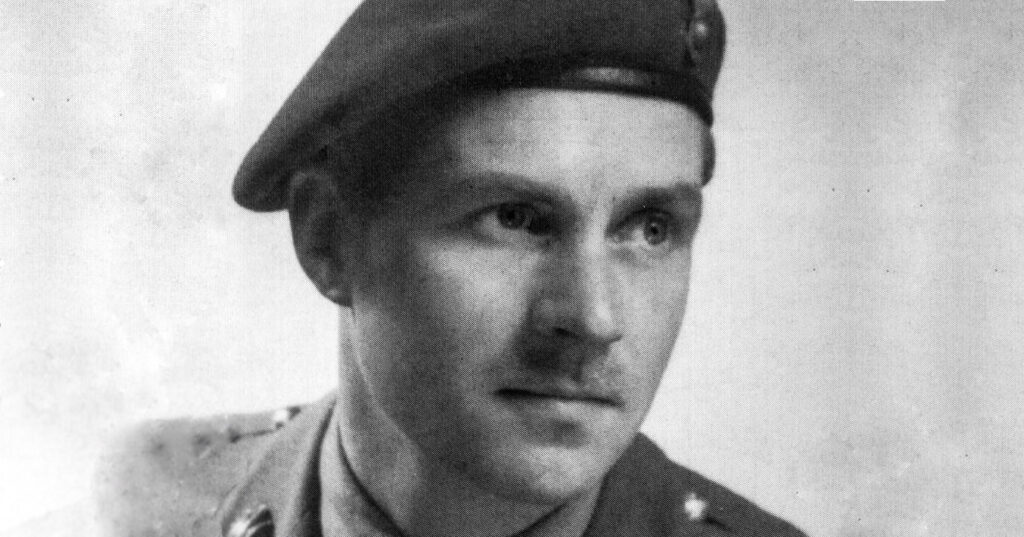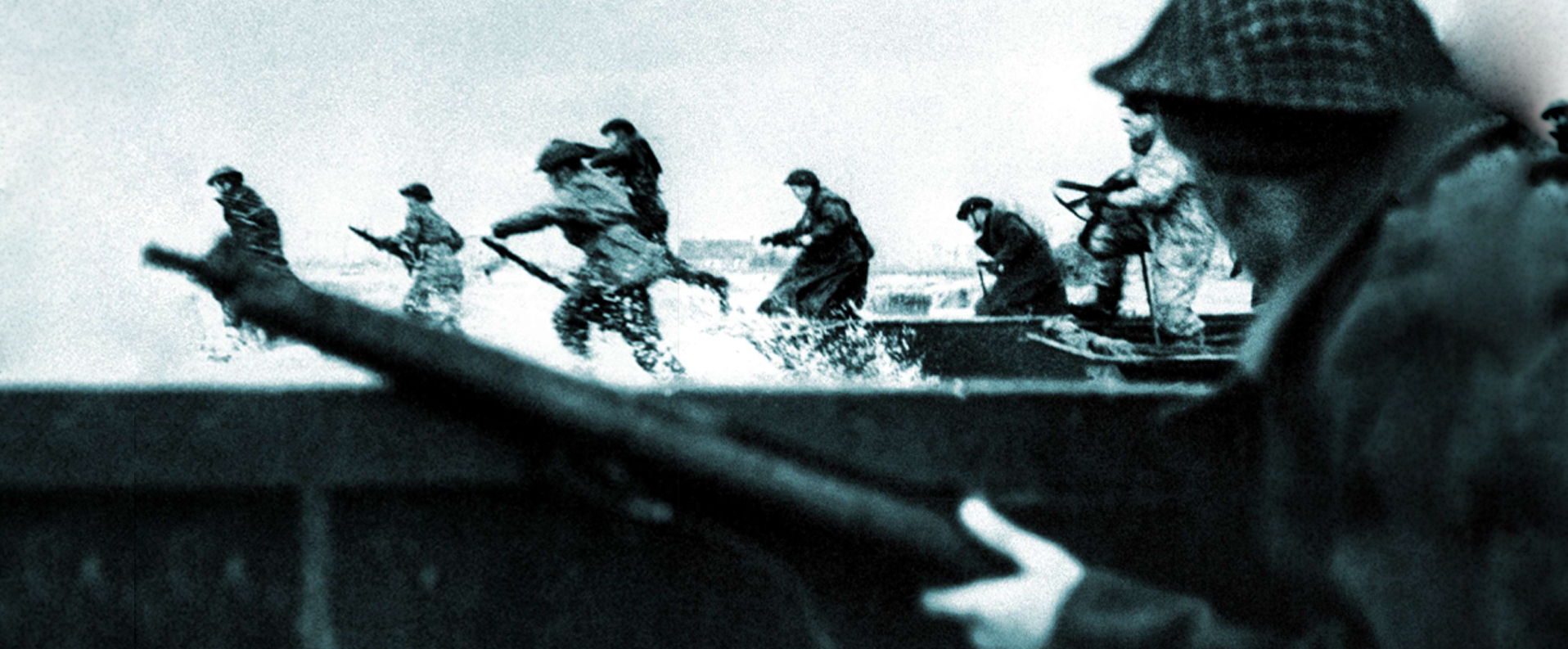
Published in The Mail On Sunday on 24 July 2022.
Major Colin Ogden-Smith volunteered for a group known as the Jedburghs
Small Breton community in France still holds a special service every other year
The service will commemorate the gallantry of the British Special Forces office
At 11am next Saturday, in the heart of the French countryside, up to 100 people will attend a moving ceremony.
The event is to remember the lives of three men who died as a result of a daring wartime mission behind enemy lines nearly 80 years ago.
The service will commemorate the gallantry of a British Special Forces officer, Major Colin Ogden-Smith, a brave French resistance fighter and a local farmer, who both also paid the ultimate price for defying Nazi occupiers.
As the author of seven books on courage and as a collector of gallantry medals, I firmly believe those who have given their lives for their country and wider freedoms must never be forgotten.
And so I was deeply touched to discover recently that a small Breton community still holds this service every other year.
Today, with the help of Ogden-Smith’s relatives and residents living in and close to the village of Querrien, I can recount the extraordinary events of July 29, 1944 – and explain why the valour of these three heroes will, hopefully, be championed for ever more.
One thing is certain: without men such as Colin Ogden-Smith, Maurice Miodon and Louis Fiche, France would never have been liberated and Hitler would not have been defeated.
The story begins in mid 1944 when the Allied Forces were about to launch Operation Overlord, the invasion of German-occupied France. On June 6 1944, the D-Day landings took place along 60 miles of Normandy coast, with the British and Canadians going ashore on the eastern beaches and the Americans landing to the west. Nearby Brittany, with its deep-water ports, was also seen as strategically important and so, despite the area being well defended by the Germans, British Special Forces units were inserted into the region.
In the first week of July, Major Ogden-Smith learnt that it was time for his own three-man team to go into action. At that time, he was 34 years old and the middle of three sons who all served with distinction in the British Armed Forces during the war. He was married with a six-month-old daughter.
Ogden-Smith had been among the first to volunteer for the newly formed Commandos, and had already seen action in North Africa and Crete. In 1942, he transferred to the highly-secretive Special Operations Executive (SOE) and joined the Small Scale Raiding Force to carry out raids across the Channel.
Next, he volunteered for a clandestine group known as the Jedburghs who were soon being trained to parachute into enemy-occupied France in the aftermath of D-Day to link up with the French Resistance, or Maquis.
Ogden-Smith would be leader of Team Francis, one of six Jedburgh teams dropped into Brittany at that time. The plan was to hide out in the south-eastern corner of the Finistère departement, deep behind enemy lines.
Ogden-Smith intended to contact all the various Maquis groups in the area, assess their manpower and firepower and, where necessary, arrange arms drops for them. The ultimate aim, of course, was to help drive out the German occupiers as the Allied forces advanced through France.
Shortly after 10.30pm on the evening of July 9, fresh from their final briefing, the three-man team took off from RAF Harrington in Northamptonshire, in a modified Liberator bomber.
The local Maquis had received a message to expect the men and had been given a DZ (Drop Zone) location, a small and remote field on the edge of the Finistère departement. As the aircraft approached shortly after 2am, three bonfires were lit to mark the DZ for the pilot who flew down to 600ft for the men to parachute.
Ogden-Smith, the last of the three men to jump, was soon in difficulty, landing not in a field but instead in dense woodland several hundred yards from the intended DZ, having overshot his target.
It meant he, unlike his two comrades, missed his Maquis reception committee and would eventually have to meet his teammates, Frenchman Guy Le Borgne, 24, and fellow Briton, Arthur Dallow, 20, at one of two pre-agreed RV (rendezvous) points.
After hiding out for three nights, Ogden-Smith, who was in uniform and armed with a rifle and a pistol, encountered a farmer on the morning of July 12. Fortunately, the man was trustworthy and helped him link up with the Maquis and his two Team Francis comrades. For the next few days, the men worked with the French Resistance.
On July 14, they had arranged an arms drop but the Germans were waiting and, in a huge firefight near the commune of Scaër, 24 patriots were killed and most of the arms supply lost. The Germans knew too that Allied troops had infiltrated the area and sent out seemingly endless patrols in a bid to capture them.
For the next two weeks, Team Francis played a dangerous game of hide-and-seek with the German Army and security forces, never staying more than 48 hours in the same place, while also working with the Maquis.
On the night of July 28, Ogden-Smith rested with his team, who by now included two Resistance men, at Kerbozec farm and stayed there the next day. The farm was owned by Louis Fiche, 71, and run with the help of his wife Marie-Jeanne, their son Louis Jnr and daughter Eliane, then just 16. Louis Jnr was an active member of the Maquis.
On the evening of July 29, shortly after 8pm, nearly 70 German troops and security police descended on the farm, having been tipped off by a collaborator.
As they tried to surround the farm, a shoot-out began in the fields close to the farmhouse. Barthélémy Guyader, one of the Resistance fighters, was soon shot and wounded but he and Dallow managed to lay low in a ditch as the fighting escalated.
During the impending chaos, Le Borgne, one of the three members of Team Francis, surprised a German officer and shot him dead, before making his escape. Ogden-Smith and Miodon, a second Resistance fighter, were not so lucky having been spotted in a water-filled ditch close to their hide-out. The British major and French sergeant began shooting, desperate to keep the Germans at bay.
Eventually, Ogden-Smith broke cover, but before he could reach a hedge he was hit by a burst of machine-gun fire. Badly wounded, he reached for his morphine and also tried to bandage his heavily bleeding stomach. Nearby, Miodon was also injured, having been hit by shrapnel from a hand grenade. However, he did not want to be caught alive, knowing perhaps he would almost certainly be tortured and butchered.
Raising his rifle and pistol, he advanced towards dozens of the enemy, firing until he ran out of bullets. A mass of enemy firepower hit him, leaving him far more seriously wounded than before.
Ogden-Smith died soon afterwards, his rifle and ammunition at his side. The 45-minute firefight was over.
Meanwhile, Louis Fiche Snr, who had been tending his cows more than 100 yards away, was confronted by the Germans. Hard of hearing, he was confused by their questions and their patience soon ran out. Fiche was murdered in cold blood, first bayoneted in the back and then shot in the chest.
Miodon was still alive at this point, but not for long. A German soldier finished him off with two shots to his head as he lay on the ground. Before leaving, the soldiers set fire to the family’s farmhouse.
Next morning the three men were buried in shallow graves at the farm because the Germans refused to allow their bodies to be removed to the local cemetery. Louis Fiche’s grieving widow, Marie-Jeanne, made a wooden cross for each makeshift grave.
Le Borgne and Dallow escaped unscathed from the farm shoot-out and continued to work with the Resistance until the area was liberated by the Allies in August 1944.
The Maquis quickly identified two suspects who they believed betrayed Team Francis – a Belgian couple who had allegedly collaborated with the Germans. They were tried and executed only six days after the battle at the farm.
Once back in Britain, Le Borgne filed a report in which he recommended Ogden-Smith for a posthumous British gallantry award but he was eventually only awarded a Mention In Despatches.
After the war, with the permission of their respective families, the bodies of the three heroes of the Battle of Kerbozec were exhumed and today the remains of Ogden-Smith and Miodon lie side by side at Guiscriff Communal Cemetery. Many local French men and women wrote to Ogden-Smith’s widow after the war and thanked her for her husband’s gallantry and self-sacrifice.
Even more significantly, three years after his death, on July 29, 1947, they held a service near Kerbozec farm that commemorated the bravery of the three men. This service continues to be held every other year and the next occasion will be on Saturday.
Among those to have attended over the years is Sam Gardner, the great-niece of Ogden-Smith. Mrs Gardner told me that just over a decade ago, while living in Paris, she had put her great uncle’s name into Google. There she found a message from Peter Jacobs, a former RAF officer turned military historian, who was seeking more information on Ogden-Smith.
Mrs Gardner contacted him, learnt about the commemoration service and decided to attend in 2012 with her mother, Angela Weston, and Mr Jacobs.
‘It was an incredible trip. On the first day, we met Marcel Moysan, then the local mayor, and he welcomed us so warmly. He was the loveliest, sweetest man. On the same day, Eliane, the daughter of the farmer who was killed, gave us a tour of where ‘le combat’ had taken place.
‘The next day we attended the commemoration and it was so moving. We had expected it to be very low key, but there were war veterans with their medals, police and firemen in uniform, lots of flags and a big public address system.
‘They had photos of the three men who had died on the same day at the farm. I gave a speech in French and my mother gave a speech in English, which I translated into French. It was so emotional, we had to fight to hold back our tears.’
No one has done more to champion the bravery of the three men than Marcel Moysan, who presided over around ten of the ceremonies as Mayor of Querrien from 1995 to 2014. Born and bred in the village and now 72, he said of Ogden-Smith: ‘As the leader of the Jedburgh team, his courage made him a great hero to us all and we have admired what he did for nearly 80 years.’
Yves Naour, then aged 13, and his father, Francois, were at their family mill close to Kerbozec Farm on the night of the attack in 1944 and were detained and questioned by the Germans for more than two hours. His father was taken at gunpoint to the spot where Ogden-Smith lay dead and three times a German officer demanded: ‘Did you know this terrorist?’
Each time he said he did not and eventually the lives of the father and son were spared.
Mr Naour, now 91, who always attends the service, told me: ‘The events of that evening have stayed with me all my life because I was so frightened.’
Next Saturday’s service will be presided over by Stéphane Cado, the current Mayor of Querrien, and Georges Guilchet, the president of the Querrien Old Comrades’ Association. Mr Cado said: ‘The three men who died were all heroes and they must never be forgotten.’
Ogden-Smith is still known affectionately by locals as ‘le majeur Anglais’ – the English major.
Mr Guilchet spoke with sadness of how his father, Edouard, had been arrested by the occupiers as a suspected Maquis member and taken to a concentration camp in Germany where was treated brutally and died in 1944, aged 41.
Mr Guilchet, then aged just three and now aged 81, said: ‘We will never stop holding this ceremony. It is important the younger generation understand the sacrifices that were made for their freedom.’
I find it incredibly uplifting that, eight decades on, scores of French men and women will gather next weekend to commemorate the life of a British Special Forces officer they never met and to champion the heroism of two of their countrymen. This close-knit Breton community has moved on, but it has never forgotten.
Read this article on the DailyMail.co.uk
For more information, visit:
LordAshcroftOnBravery.com


